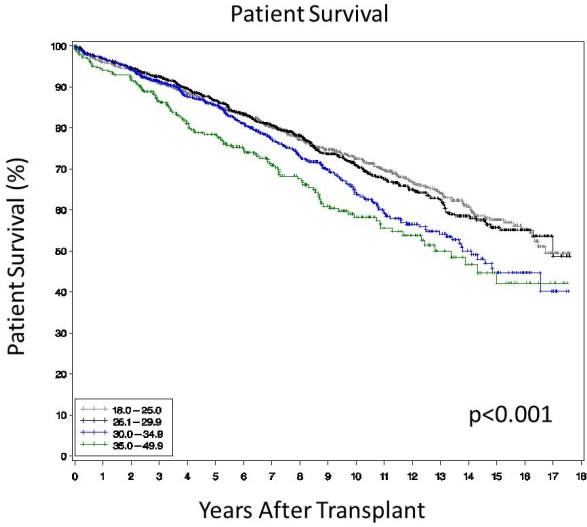Renal Transplant in Obese Recipients: Consideration of Donor and Recipient Factors Can Improve Outcomes.
P. Stahler, J. Mezrich, G. Leverson, D. Kaufman, H. Sollinger.
Division of Transplantation, University of Wisconsin-Madison, Madison, WI.
Meeting: 2016 American Transplant Congress
Abstract number: B210
Keywords: Graft survival, Kidney transplantation, Obesity, Surgical complications
Session Information
Session Name: Poster Session B: Kidney: Cardiovascular and Metabolic
Session Type: Poster Session
Date: Sunday, June 12, 2016
Session Time: 6:00pm-7:00pm
 Presentation Time: 6:00pm-7:00pm
Presentation Time: 6:00pm-7:00pm
Location: Halls C&D
Background: Obesity rates in the transplant population are increasing. Previous studies are limited by small sample sizes, short-term follow up, and conflicting results. Factors including donor selection and recipient BMI could be optimized to improve outcomes.
Methods: Single center retrospective review of adult renal transplants from 1998-2013. Complications, graft and patient survival were calculated. Patients were classified according to BMI and donor type. Univariate and multivariate analysis were performed to determine independent risk factors for graft loss.
Results: 3,044 recipients were stratified by BMI (18-25 n= 975, 25.1-29.9 n=1067, 30-34.9 n=679, >35 n=323). There was no difference in the type of donation (DBD, DCD, LRD) between BMI groups (p=0.460) although patients with BMI>35 did receive a higher proportion of LRD than patients with BMI<35 (43.6% vs 38.8%). Post transplant, 5 and 10 year patient survival was significantly lower in patients with BMI>35 vs. BMI<35 (78.5% vs 85.9%, 58.3% vs 69.1%)(p<0.001) . Likewise, 5 and 10 year death censored graft survival was significantly lower in patients with BMI>35 vs. BMI<35 (78.5% vs 86.5%, 62.9% vs 74.2%)(p=0.0014)
. Likewise, 5 and 10 year death censored graft survival was significantly lower in patients with BMI>35 vs. BMI<35 (78.5% vs 86.5%, 62.9% vs 74.2%)(p=0.0014) . Multivariate analysis demonstrated BMI>35 (p<0.0001, HR 1.51), age>60 (p<0.0001, HR 1.80), DGF (HR 1.75, p<0.0001), KDPI>85 (HR 1.93, p<0.0001), and pre transplant T2DM (p<0.0001, HR 1.65) as independent risk factors for graft loss. Receiving a LRD kidney was protective (p=0.013, HR 0.84).
. Multivariate analysis demonstrated BMI>35 (p<0.0001, HR 1.51), age>60 (p<0.0001, HR 1.80), DGF (HR 1.75, p<0.0001), KDPI>85 (HR 1.93, p<0.0001), and pre transplant T2DM (p<0.0001, HR 1.65) as independent risk factors for graft loss. Receiving a LRD kidney was protective (p=0.013, HR 0.84).
Conclusion: Patients with BMI>35 experience a higher rate of death, graft loss, and complications. Consideration of donor type, quality of deceased donor organs, and modification of pre transplant BMI are important factors to improve transplant outcome.
CITATION INFORMATION: Stahler P, Mezrich J, Leverson G, Kaufman D, Sollinger H. Renal Transplant in Obese Recipients: Consideration of Donor and Recipient Factors Can Improve Outcomes. Am J Transplant. 2016;16 (suppl 3).
To cite this abstract in AMA style:
Stahler P, Mezrich J, Leverson G, Kaufman D, Sollinger H. Renal Transplant in Obese Recipients: Consideration of Donor and Recipient Factors Can Improve Outcomes. [abstract]. Am J Transplant. 2016; 16 (suppl 3). https://atcmeetingabstracts.com/abstract/renal-transplant-in-obese-recipients-consideration-of-donor-and-recipient-factors-can-improve-outcomes/. Accessed December 26, 2025.« Back to 2016 American Transplant Congress
